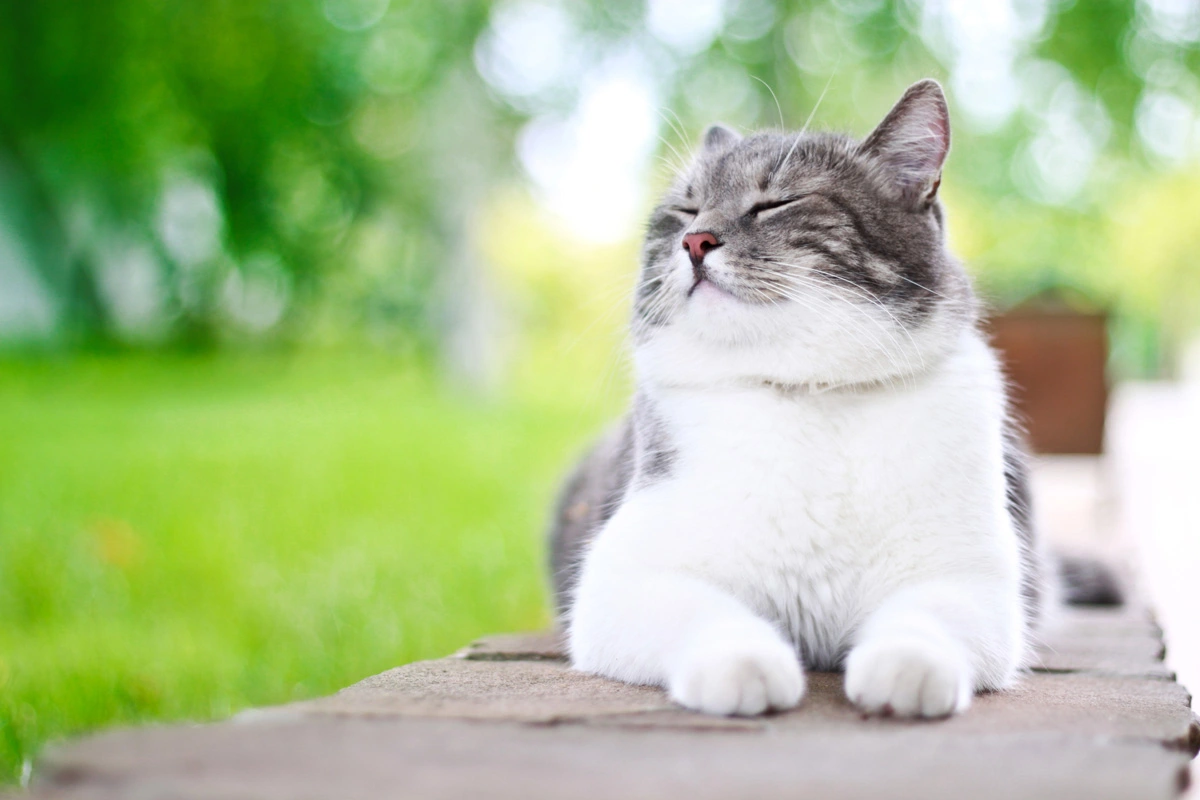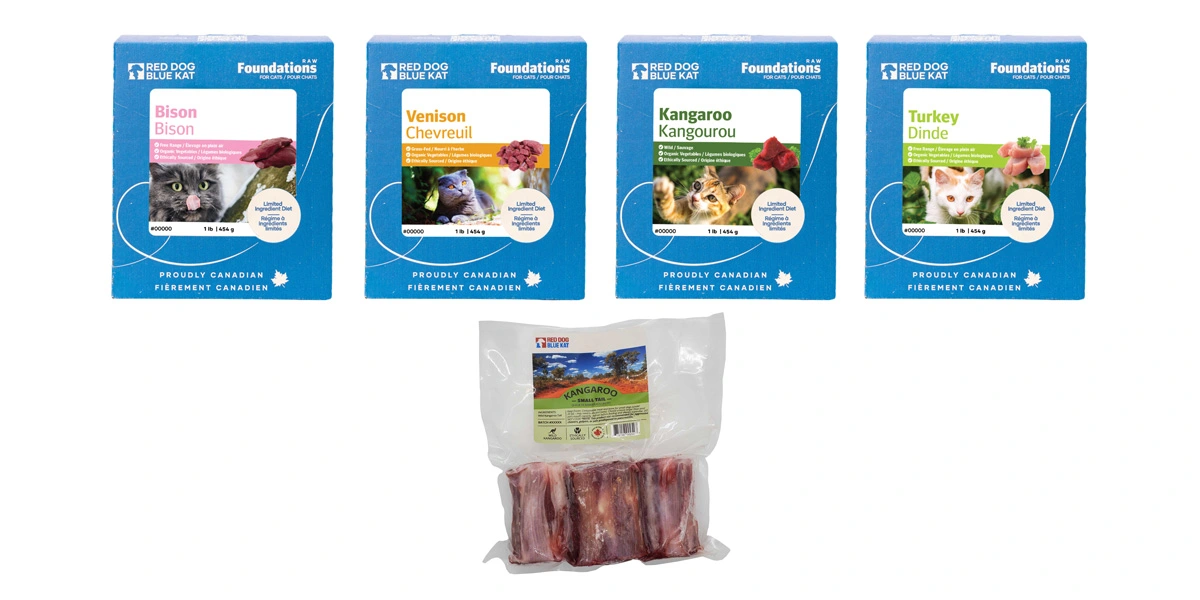When you’d describe your cat’s walk as more of a waddle than a runway strut, then your precious cat’s fluff might be more fat than fur. But our feline overlords can be loud and forever demanding when they think they’re being denied their “normal” meal amounts.
So how do you take definitive steps toward curbing your cat’s paunch?
Check out Part 1 of our Epidemic of Fat Cats series, where we go over the major health concerns for overweight cats, why you should start your cat’s weight loss journey under your veterinarian's supervision, and 3 main weight loss challenges your cat may be facing.
This week, we’re getting into the nitty gritty of implementing your cat’s new lifestyle with a healthy calorie reduction plan while carefully increasing their exercise routines. Finally, we’ve got some tips and tricks to make the whole process go smoothly. So let's get into it!

Skip Ahead...
Four Steps to Feline Weight Loss
So you’ve gone through all the steps outlined in Part 1 of our series, and your veterinarian has given your cat the all-clear to commence their weight loss journey.
You’ve got all your numbers: your cat’s Body Condition Score (BCS), and you know how to reassess your cat’s BCS. You’ve got their current weight, goal weight, and the amount of kcal (kilocalories) they need to consume daily.
Now you need to steel yourself for the commitment: losing weight is hard for everyone, especially when you can’t explain to your kitty why you’re doing this—you’re going to have to convince them their reduced meals is a great idea!
To get started…
1. Accuracy is Key
You’ll want to start with an accurate kitchen scale. This might seem like overkill at first, but we promise it will make this journey easier for you. You’ll be grateful to have a quick and precise way of measuring how much your kitty needs to eat per day to successfully follow their weight loss plan.
Start by weighing out what you would normally feed in a day in one dish, then fill another dish with their new prescribed caloric budget and compare the two. There are a few benefits to having this visual.
First, it’s your reality check. Chances are you’ve been listening to your kitty’s vocal demands for more food, obeying too readily, and way overfeeding! We can’t judge you—cats can be quite adamant. But this is your chance to set things right. Looking at these two amounts helps reset your standards and gives you a starting point and end goal for reducing their daily allotment. You’ll be working gradually towards that smaller amount for the next few weeks.
Next, you’ll want to make sure your scale is accurately weighing in ½ gram increments. Your cat’s food might list their calories in kcal/kg. This means that (as an example) 1,140kcal/kg equals 1.14kcal per gram or 0.57kcal per half a gram. So while half a gram might not seem like a lot for us, you can see how those calories might start to add up for your kitty!
Some cats seem to measure their meals by how many bites they take, not necessarily by how full they may seem afterward. This means that if you’re feeding a higher calorie meal, like RDBK’s Lamb or Wild Boar Foundations, then the mere volume of food might not be enough to satisfy your kitty, even if it’s the same calorie amount.
If your cat is telling you they still need more food after trying more calorie-dense meals, then you may want to switch to our Venison or Kangaroo Foundations meals to feed more grams with fewer calories. Adding new flavours may also help distract them from the difference in amounts, too!

2. Get Your Kitty Moving
If you read part 1 of our cat weight loss series, you may remember us saying that exercise alone is not enough to start skimming the pounds off your cat—which isn’t to say it isn’t useful, though!
Remember that too much high-intensity exercise too soon can harm overweight cats, as their joints, ligaments, and tendons aren’t meant to handle their extra bulk. Start introducing increased activity gradually and within their tolerance level. Play in 1–2 minute increments once or twice a day and work up to intense play periods of 5 minutes three times a day.
Jumping, climbing, and pouncing are all natural behaviours for your kitty, so take some time to figure out what toys or games motivate them and what time of day they seem to have the most energy to engage in a good play session. Keep note of what activities seem to give them the wide-eyed zoomies or bum wiggles, and see if you can get them to replicate that behaviour at your next playtime!

3. Start Reducing
Take 10% off your cat’s meals every two weeks until you reach their prescribed caloric intake. It might be tempting to try and wean them off faster, but you’ll be thankful you didn’t rush through the process.
Gradually reducing their intake over a longer period of time allows your cat to adjust to their new food portions without leaving them hungry, or worse, cue them to start begging. We went over some methods to curb begging behaviours in Part 1, but the key is to stay strong and DON’T give in—if you do, your cat will remember, and the begging will be even worse next time!
That two-week meal reduction is also a great time to weigh your cat and perform another BCS—anywhere between 2–4 weeks is fine, but if you’re already reducing their food, why not make an event of it? Remember to record your findings in your cat’s weight loss journal! You’ll find that either the incremental successes will be rewarding, or a lack of changes may alert you to some necessary restructuring of your plan.
Once your cat is eating their prescribed caloric intake, continue feeding that amount while weighing them and taking new BCSs every 2–4 weeks. It might take some time for your kitty to hit their initial goal weight, but you should see approximately 0.5% of weight loss each month.
Important: If you’re not seeing any results after the first 4–6 weeks, take another 10% off, but don’t continue reducing past the 2–3 month mark without any change. It’s possible to get to the point where you’re feeding such a small amount of food that your cat is no longer getting their minimal nutritional requirements.
If you do not see changes by this point, then it’s time to revisit your veterinarian for a diet change or supplementation recommendations!
Treats:
Generally, cutting out treats from the diet completely makes a huge impact on weight loss success. Overindulgence in treats can blow out a weight loss plan very easily. If you must feed treats, we recommend feeding low-calorie options, like pieces of cat-safe low starch raw veggies or fruit (eg broccoli, cantaloupe).
Alternatively, once you are diligent about calorie counting*, small freeze-dried sardines or single ingredient freeze-dried chicken breast are also good options, Giving chicken necks/edible bone meals can also help to keep them busy and keep them fuller longer.
*Calorie counting: Calculate 10% of the total caloric intake allowed per day, subtract this amount from what they are fed in their regular meals and feed this amount in treats.

4. Get Reassessed
Let’s say it’s working…hooray! Your cat is finally at their goal weight as given by your veterinarian months ago. At this point, it’s time for a reassessment to confirm they are indeed at their ideal weight, that their Muscle Condition Score (MCS) hasn’t deteriorated, and that their BCS is just as it should be. There’s even a chance your veterinarian might tell you your cat could stand to lose even more weight, in which case your journey would continue.
However, if your vet tells you you’ve successfully reached your goal, then it’s time to celebrate…by feeding your cat a little bit more!
Once you’ve been given the Cat Weight Loss Guru seal of approval from your vet, you can increase your cat’s meals by 2.5–5% to maintain their new svelte look and BCS. This number might vary over the coming weeks—if you notice some of those kitty pounds starting to creep back on, you may need to reduce it by 2.5% or thereabouts and continue to monitor.
Key Tips to Consider:
NEVER allow your cat to fast—they still need to be getting regular meals. If your cat refuses to eat new food, you may have to try some tricks to get them to eat (i.e. mixing with the original food and gradually increasing the new portions) or go back to their old food entirely.
Raw food is often favoured for weight loss, as it has higher protein and moisture content with lower carbohydrates. However, every pet is different, so keep an open mind about what your cat will tolerate.

Rotating proteins with lower calorie options like Kangaroo, Buffalo, and/or Venison may help accelerate your cat’s weight loss journey. When it comes to poultry, RDBK Turkey Foundations meal has fewer calories than our Chicken recipe.
Your cat’s battle of the bulge might not be over yet! Cats that have issues with weight gain and obesity will often have lower caloric needs even AFTER they lose the weight. This means that an “average” cat feeding calculation could still be too high for your cat. Keep this in mind when changing foods, looking into other products, and remembering to adjust amounts as needed.
Thinking that once the weight is off, it’s back to life as usual—but it’s not! “Life as usual” is what got your cat into this mess, so understand that embarking on a weight loss journey isn’t a one-and-done accomplishment—it’s a lifestyle commitment! Before you know it, weighing out your cat’s food and scheduling exercise playtime will become second nature, and it’ll play a pivotal role in keeping off the weight for life.
Want more? Check out Pet Obesity Prevention for more information on your pet’s weight management!
The Long Run
It might not be easy, but anything worth doing is worth doing right. Whenever you get stuck or feel worn down by a demanding cat, remember that you’re working towards giving them the gift of a longer, healthier, and better quality of life.
Best of luck with your pet’s weight loss journey—we can’t wait to see your results! Don’t forget to take a “before” and “after” picture and send it to us at Red Dog Blue Kat on Facebook, or tag us at @reddogbluekat on Instagram!
Want to Check Our Sources?
Association for Pet Obesity Prevention website: https://petobesityprevention.org/pet-weight-check accessed on March 23/22
Hoenig M. The Cat as a Model for Human Obesity and Diabetes. J Diabetes Sci Technol 2012;6:525-33
deGodoy MR, Shoveller AK. Overweight adult cats have significantly lower voluntary physical activity than adult lean cats. J Feline Med Surg 2017;19:1267-73
Chandker M, Cunningham S, Lund Em, et al. Obesity and Associated Comorbidities in People and Companion Animals: A One Health Perspecitve. J Comp Pathol 2017;156:296-309
Phillips AM, Coe JB, Rock MJ et al. Feline obesity in veterinary medicine: insights from a thematic analysis of communication in practice. Front Vet Sci 2017;4:117
Floerchinger AM, Jackson MI, Jewell DE, et al. Effect of feeding a weight loss food beyond caloric restriction period on body composition and resistance to weight gain in cats. J Am Vet Med Assoc 2015;247:365-74
Slingerland LI, Fazilova VV, Plantinga EA, et al. Indoor confinement and physical inactivity rather than the proportion of dry food are risk factors in development of feline type 2 diabetes mellitus. Vet J 2009; 179:247-53
Lund E, Armstrong PJ, Kirk CA, et al. Prevalence and risk factors for obesity in adult cats from private US veterinary practices. Intern J Appl Res Vet Med 2005;3(2):88-96
Rollins AW, Shepherd M. Pathophysiology of obesity: Metabolic effects and inflammatory mediators. In: Obesity in the Dog and Cat, First ed. Taylor & Francis 2009.